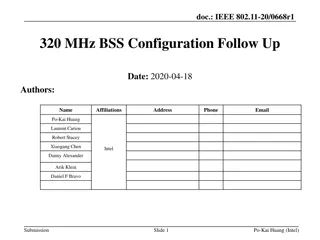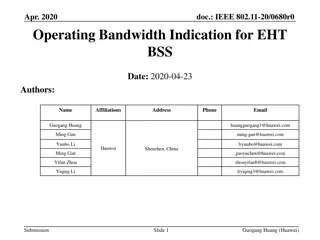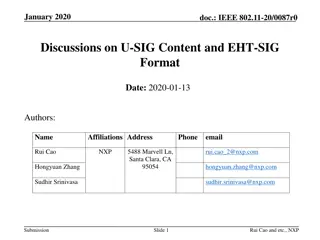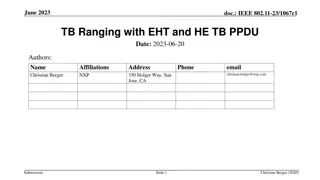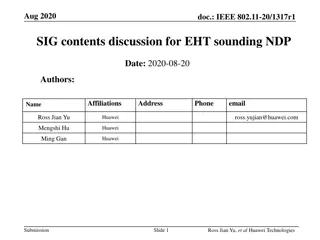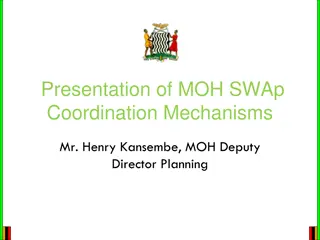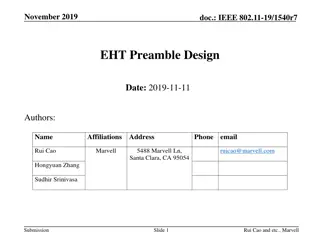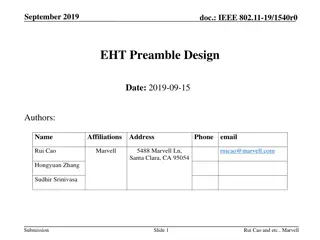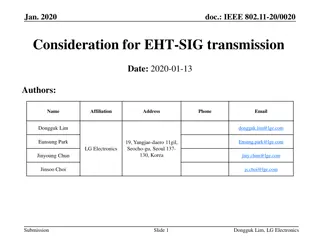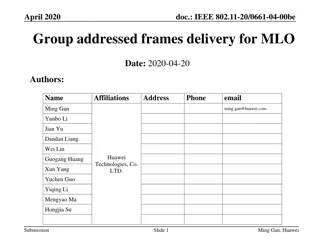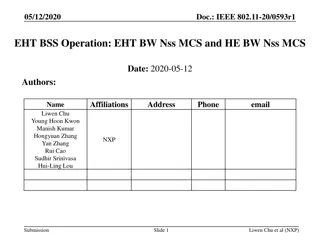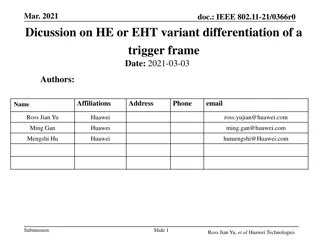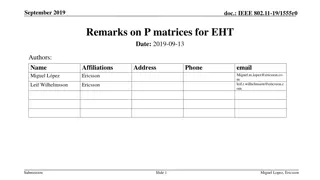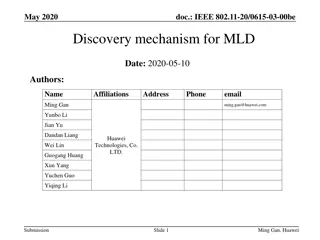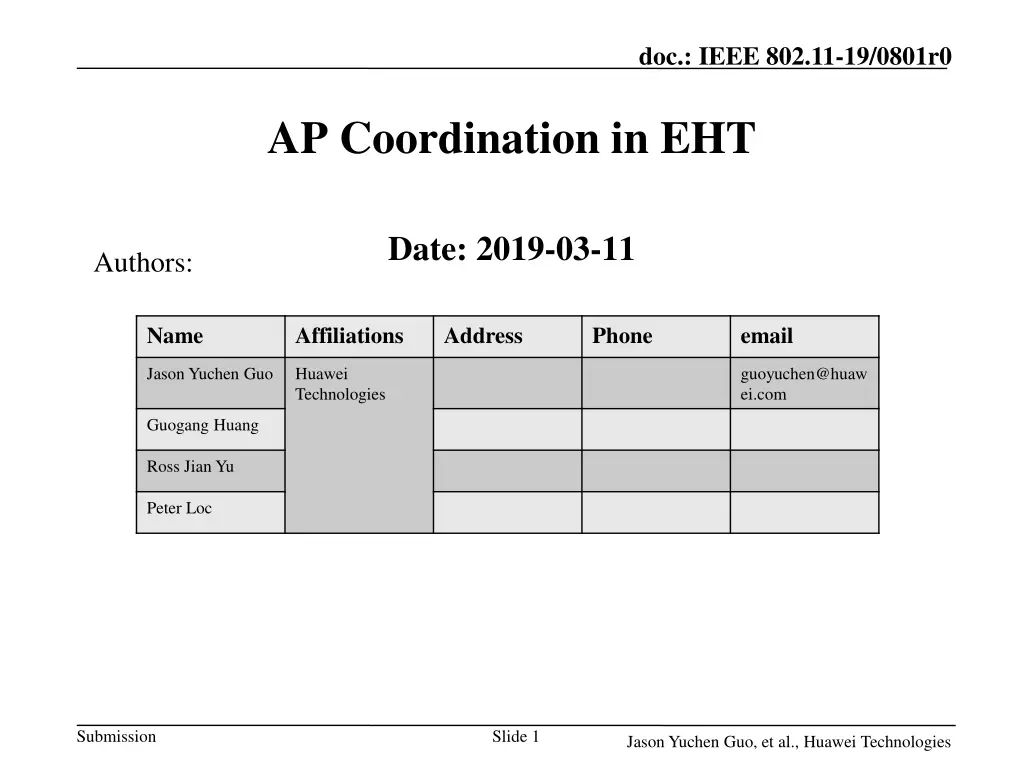
Introducing New Modes of AP Coordination in IEEE 802.11-19/0801r0
Explore the innovative approach to AP coordination in IEEE 802.11-19/0801r0, focusing on Coordinated Spatial Reuse and its advantages in managing interference and enhancing network performance. Discover how this new mode can revolutionize wireless communication protocols.
Download Presentation

Please find below an Image/Link to download the presentation.
The content on the website is provided AS IS for your information and personal use only. It may not be sold, licensed, or shared on other websites without obtaining consent from the author. If you encounter any issues during the download, it is possible that the publisher has removed the file from their server.
You are allowed to download the files provided on this website for personal or commercial use, subject to the condition that they are used lawfully. All files are the property of their respective owners.
The content on the website is provided AS IS for your information and personal use only. It may not be sold, licensed, or shared on other websites without obtaining consent from the author.
E N D
Presentation Transcript
doc.: IEEE 802.11-19/0801r0 AP Coordination in EHT Date: 2019-03-11 Authors: Name Affiliations Address Phone email Jason Yuchen Guo Huawei Technologies guoyuchen@huaw ei.com Guogang Huang Ross Jian Yu Peter Loc Submission Slide 1 Jason Yuchen Guo, et al., Huawei Technologies
doc.: IEEE 802.11-19/0801r0 Introduction There are many types of AP coordination [1-4], which can be summarized into two levels [4] Level 1: the data of one user is sent from a single AP use the term Coordinated in their names Level 2: the data of one user is sent from multiple APs use the term Joint in their names For the Coordinated level, the following types are considered Coordinated BF Coordinated OFDMA For the Joint level, the following types are considered Joint processing Multi-user case Single-user case This contribution proposes a new mode of AP coordination under the Coordinated level: Coordinated Spatial Reuse Submission Slide 2 Jason Yuchen Guo, et al., Huawei Technologies
doc.: IEEE 802.11-19/0801r0 Coordinated Spatial Reuse Coordinated spatial reuse is parallel transmission of two APs in a coordinated way Coordinated spatial reuse can be used when BSS1 and BSS2 are relatively far from each other, the meaning of relatively far is two folds: Not near: interference is not so strong, nulling may not be needed, power control is enough Not too far: the channel state is busy (received signal power > -82dBm) In 11ax, spatial reuse can be used in this case, but it is an uncoordinated way Many SR transmissions can be initiated, which makes the interference hard to control With AP coordination in EHT, we can do it in a coordinated way, e.g., use a trigger frame to initialize the transmission Advantage: simple, less feedback overhead comparing with co-BF; less interference comparing with SR Control Info AP2 AP1 Interference controlled Power Power controlled controlled STA1 STA2 Submission Slide 3 Jason Yuchen Guo, et al., Huawei Technologies
doc.: IEEE 802.11-19/0801r0 Coordinated Spatial Reuse Furthermore, coordinated spatial reuse can be combined with coordinated OFDMA E.g., STA1 and STA4 are near to their own APs, and far from the interfering AP, they can share the same RU/channel; STA2 and STA3 will see relatively larger interference, they can use different RUs/channels STA2 STA4 Control Info STA3 STA1 AP1 AP2 Coordinated spatial reuse STA1 STA4 RU1 RU2 STA2 Coordinated OFDMA RU3 STA3 AP1 AP2 Submission Slide 4 Jason Yuchen Guo, et al., Huawei Technologies
2018 doc.: IEEE 802.11-19/0801r0 System Level Simulation Simulation Scenario We use the enterprise scenario defined in [5] Simulation setting: Number of AP: 32 Number of STAs per BSS: 10 BSS Range: 20m Bandwidth: 20MHz @ 2.4GHz Traffic model: full buffer Packet size: 1500 bytes Data MCS: link adaptation Antenna#: AP 1, STA 1 20 m 20 m BSS9-12 BSS13-16 BSS24-28 BSS29-32 BSS1-4 BSS5-8 BSS17-19 BSS20-23 2 m STA1 STA4 2 m STA2 STA3 Submission Slide 5 Jason Yuchen Guo, et al., Huawei Technologies
2018 doc.: IEEE 802.11-19/0801r0 Simulation Results UL results: Comparing with EDCA, Coordinated SR has 14%~53% throughput gain Comparing with SR, Coordinated SR has up to 34% throughput gain when the number of slave APs is more than 1 The packet loss is much lower since the interference from slave APs can be predicted More collaborative APs can bring more throughput gain Throughput Packet Loss 30 50 Co-SR OBSSPD EDCA Co-SR OBSSPD EDCA 45 40 UL Cell average throughput/Mbps 25 35 UL Data packet lossrate/% 53% 34% 30 20 25 14% 20 15 15 10 5 10 0 1 2 3 4 5 1 2 3 4 5 Max number of salve APs Max number of salve APs Submission Slide 6 Jason Yuchen Guo, et al., Huawei Technologies
2018 doc.: IEEE 802.11-19/0801r0 Simulation Results UL results: 10% percentile throughput UL data Sinr CDF 1.5 1 Co-SR OBSSPD EDCA Co-SR-1-slave-AP Co-SR-2-slave-AP Co-SR-3-slave-AP Co-SR-4-slave-AP OBSSPD EDCA 1.4 0.9 1.3 UL 10% percentile throughput/Mbps 1.2 0.8 1.1 0.7 1 0.9 0.6 0.8 F(x) 0.5 0.7 0.6 0.4 0.5 0.3 0.4 0.3 0.2 0.2 0.1 0.1 0 0 0 10 20 30 Receive Sinr/dB 40 50 60 70 1 2 3 4 5 Max number of salve APs Although the SINR of the co-SR is lower, the number of parallel links is higher, which contributes to the throughput gain The cell-edge throughput of Co-SR is much better than EDCA and OBSSPD The cell-edge throughput decreases with the number of slave APs since the interference increases, but still in a controllable region Submission Slide 7 Jason Yuchen Guo, et al., Huawei Technologies
2018 doc.: IEEE 802.11-19/0801r0 Simulation Results DL results: Comparing with EDCA and SR, Coordinated SR has 20%~27% throughput gain when the number of slave APs is more than 2 Packet Loss Throughput 25 50 Co-SR OBSSPD EDCA Co-SR OBSSPD EDCA 40 DL Cell average throughput/Mbps DL Data packet lossrate/% 30 20 20% 27% 20 10 15 0 1 2 3 4 5 1 2 3 4 5 Max number of salve APs Max number of salve APs Submission Slide 8 Jason Yuchen Guo, et al., Huawei Technologies
2018 doc.: IEEE 802.11-19/0801r0 Simulation Results DL results: SINR distribution DL data Sinr CDF 1 Co-SR-1-slave-AP Co-SR-2-slave-AP Co-SR-3-slave-AP Co-SR-4-slave-AP OBSSPD EDCA 0.9 0.8 0.7 0.6 F(x) 0.5 0.4 0.3 0.2 0.1 0 0 10 20 30 Receive Sinr/dB 40 50 60 70 Submission Slide 9 Jason Yuchen Guo, et al., Huawei Technologies
doc.: IEEE 802.11-19/0801r0 Conclusion We propose coordinated spatial reuse as an AP coordination mode in the coordinated family. It is an enhancement of SR under the AP coordination framework It can be used together with other AP coordination modes such as co- OFDMA. Simulation results show that more than 30% throughput gain can be obtained in the UL, and more than 20% throughput gain can be obtained in the DL. Submission Slide 10 Jason Yuchen Guo, et al., Huawei Technologies
2018 doc.: IEEE 802.11-19/0801r0 Reference [1] 11-18-1439-00-0eht-distributed-mu-mimo [2] 11-18-1509-00-0eht-features-for-multi-ap-coordination [3] 11-18-1510-01-0eht-ap-coordinated-beamforming-for- eht [4] 11-18-1926-02-0eht-terminology-for-ap-coordination [5] 11-14-0621-04-00ax-simulation-scenarios Submission Slide 11 Jason Yuchen Guo, et al., Huawei Technologies
2018 doc.: IEEE 802.11-19/0801r0 Appendix CDF of DL throughput Submission Slide 12 Jason Yuchen Guo, et al., Huawei Technologies

